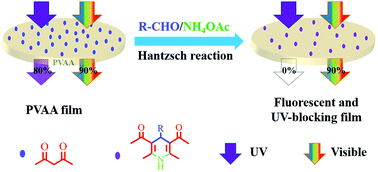Facile fabrication of a polyvinyl alcohol-based hydrophobic fluorescent film via the Hantzsch reaction for broadband UV protection†
Abstract
Excessive exposure to ultraviolet (UV) light is harmful to human health. However, the traditional preparation of anti-UV films through the doping of UV absorbers leads to unstable products. Chemical modification of polyvinyl alcohol (PVA) to fabricate functional derivatives expand the application of these materials. Herein, a 1,4-dihydropyridine (DHP) fluorescent ring with a conjugated structure as a strong UV-absorber group was introduced onto a polyvinyl alcohol acetoacetate (PVAA) film to improve its UV-blocking performance. Firstly, PVAA was prepared via transesterification using tert-butyl acetoacetate (t-BAA). Then, the Hantzsch reaction was carried out on the surface of the PVAA film at room temperature. The resulting film showed high transparency, bright fluorescence emission, good mechanical properties, and outstanding stability. The introduction of the hydrophobic carbon chain reduced the hydrophilicity and swelling capacity of the PVAA film. In addition, the conjugated structure endowed the fluorescent film with excellent UV-blocking performance, where almost 100% UVA and UVB spectra could be shielded. The UV-blocking properties of the prepared films were persistent when they were exposed to UV irradiation, solvents, and subjected to thermal treatment. This work presents a facile and environmentally-friendly strategy by which to fabricate a multifunctional PVA-based film, which holds great potential for application in the anti-counterfeiting and UV-blocking fields.



 Please wait while we load your content...
Please wait while we load your content...